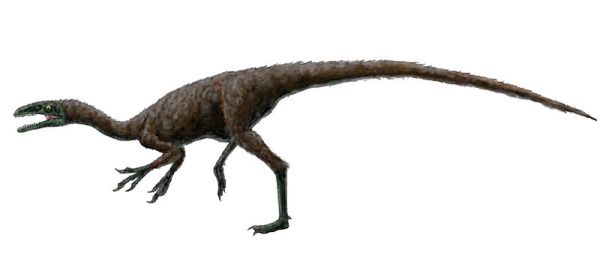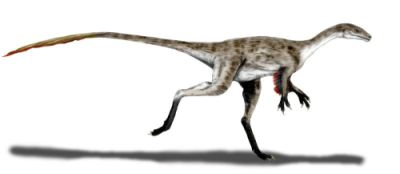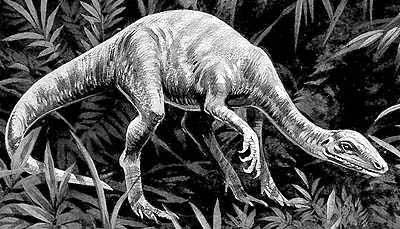Coelurosauria: Coelurosauria
Taxa on this Page
- Coelurosauria
- Coelurus X
- Compsognathidae X
- Maniraptoriformes
- Ornitholestes X

Life reconstruction of the mid Cretaceous Compsognathid Mirischia asymmetrica, Albian of Brazil; length about 2 meters. Most small coelurosaurs would have been very similar in size and appearance. These animals were covered in fine hair-like protofeathers (known to be present in the related Sinosauropteryx), and exceptional preservation reveals what appear to be bird-like air sacs (Wikipedia)
Artwork by FunkMonk (Michael B. H.), via Wikipedia, GNU Free Documentation/Creative Commons Attribution Share Alike |
Introduction: "Coelurosauria" has meant a number of different things. Originally it referred to small as opposed to large theropods - everything from Coelophysis to Ornithomimus - but this is now known to be an artificial, polyphyletic grouping group. The popular cladistic meaning is the monophyletic taxon that encompasses all advanced theropods, as well as their descendants the birds (beginning with Archaeopteryx). The terms Maniraptoria and Maniraptoriformes (refering to the grasping hands of many of these small advanced theropods) are approximately equivalent, but refer to slightly more specialised forms). (adapted from MAK)
Descriptions
 Coelurosauria: Nqwebasaurus, Piveteausaurus, Proceratosaurus, Timimus. Avetheropods closer to birds than to Carnosaurs. Padian et al. (1999). Traditionally, the smaller bipedal carnivores.
Coelurosauria: Nqwebasaurus, Piveteausaurus, Proceratosaurus, Timimus. Avetheropods closer to birds than to Carnosaurs. Padian et al. (1999). Traditionally, the smaller bipedal carnivores.
Range: from Middle Jurassic
Phylogeny: Avetheropoda: Carnosauria + * : ?Gasosaurus + (Tyrannosauroidea + Compsognathidae + (Coelurus + Maniraptoriformes)). MAK120307
Characters: nasals do not participate in antorbital fossa [H+01]; $ expanded, circular orbit; jugals reach antorbital fenestrae; Fenestra in roof of mouth; $ <16 caudals have transverse processes; "boat-shaped" chevrons; fused sternal plates; "cranial notch" between scapula & coracoid absent [H+01]; coracoid with well-developed posterior projection [H+01]; elongated forelimbs, especially manus [H+01]; semilunate carpal in wrist; metacarpal I reduced; long, thin metacarpal III ; $ ischium reduced to <2/3 length of pubis; $
loss of ischial foot; $ triangular obturator process on ischium; generally femur substantially shorter than epipodialia; $ ascending process of astragalus >25% length of tibia; knee and ankle hinge-like; fibula reduced and immobile in relation to tibia; tarsal bones elongated; metatarsal III pinched between II & IV (arctometatarsalian condition or similar); feathers?.
Notes: [1] "Coelurosauria" is a name which has been used to describe a number of different groups in this general phylogenetic area at different times. Thus, the dates are uncertain because the definitions used by different authors vary, and also because some of the earlier material is not conclusively identifiable. In these Notes, Coelurosauria is the stem group birds > Allosaurus. [2] Note the many adaptations which may limit maneuverability as they increase speed and stability to impact. ATW
Comments: Comprehensive phylogenetic analysis by Senter 2007 gives the following topology: Tyrannosauroidea + (Compsognathidae + (Arctometatarsalia + (Ornitholestes + (Therizinosauroidea + (Alvarezsauridae + (Oviraptorosauria + (Avialae + (Troodontidae + Dromaeosauridae)))))))). This has mostly been accepted by later workers in the field. MAK120307
Image: Representation of Coelurus fragilis as a feathered dinosaur, artwork by Nobu Tamura , via Wikipedia, GNU Free Documentation/Creative Commons Attribution. Compare with the old-style (pre Dinosaur renaissance) illustration below
Links: DD: Coelurosauria; Coelurosaurs!; Coelurosauria; theropods; Coelurosauria; DGF, Geological Society of Denmark, Geologisk Tidsskrift Nr. 4, 1996; Basal Coelurosauria; Oudst bekende coelurosaurier Dutch); Coelurosauria.
References: Hutt et al. 2001) [H+01]. ATW010517.
Gasosaurus constructus Dong & Tang, 1985
Synonym: ?Kaijiangosaurus lini He, 1984
Horizon: Dashanpu formation of Sichuan, China (Bathonian-Callovian)
Phylogeny: Coelurosauria : (Tyrannosauroidea + Compsognathidae + (Coelurus + Maniraptoriformes)) + *
Size: length about 4 meters, weight about 160 kg (Paul 1988)
Comments: a poorly known, medium-sized theropod, known from humerus, pelvis, femur, other postcranial elements, but no skull, Gasosaurus has features characteristic of an ancestral coelurosaurian or ancestral avetheropod, such as a primitive pelvis. Paul 1988 considers it closer to Piatnitzkysaurus (which he considered an advanced form) than Eustreptospondylus (later (2010) he places it under carnosauria (=allosauria) miscellania), whereas Holtz 2000 places it as a basal colurosaur, while Cau & Maganacu's cladogram (unpublished data, online) has it at the absolute bottom of the teanuran tree. Apart from that, no one seems to say anything about it. The Wikipedia page features rather optimistically complete skeltal rconstructions, complete with non-existant skull. Since we have no idea where to put this taxon, we've placed it at the base of the avetheropoda, with Monolophosaurus which, no doubt, is a totally unrealted form. For now we've place dit near the base of the Coelurosaurs. MAK120223
Compsognathidae: Compsognathus, Sinosauropteryx(?).
Range: Late Jurassic-Early Cretaceous. of Eur.
Phylogeny: Coelurosauria : ?Gasosaurus + (Tyrannosauroidea + (Coelurus + Maniraptoriformes) + *)
Characters: The following description relates to Compsognathus, as it is not clear what other forms may be contained in the group. About 1m; skull long and low, with sharply tapering snout; lower jaw slender, no coronoid process or external mandibular fenestrae (unusual); very lightly constructed skull , with large openings; paired skull elements not fused; orbit large; pleurocoels only in cervical vertebrae; centra spool-shaped and amphiplatyan; fan-shaped neural spines; no transverse processes on caudals; cervical zygapophyses not flexed; proximal caudal vertebrae long, slender, and somewhat spool-shaped; small curved chevrons; ribs continue to sacrum; cervical ribs double-headed, not fused to vertebrae, taper distally; fine bony gastrula; forelimb about 1/3 length of hind limb; lacks bowed ulna and extended metacarpal III; prominent obturator process on ischium; pes digit I reduced; some forms feathered (if Sinosauropteryx is *); lizard found as stomach contents; presence in Solnhofen indicates * may have been sympatric with Archaeopteryx.
Comments: now generally placed near Tyrannosaurs (Zanno et al 2009, Zanno 2010), or intermediate between Tyrannosaurs and ornithomimids (Senter 2007, Zhang et al 2008, Zhang et al 2007, Xu et al 2011, Lee & Worthy 2011). May be a paraphyletic assemblage of coelurosaurs (Chiappe & Göhlich(2010), some may be even juvenile forms of larger animals
Links:
Compsognathus sp.; Compsognathus Skeleton; Compsognathus Skull; Sino-Dino.jpg.
 Coelurus: C. fragilis Marsh 1879.
Coelurus: C. fragilis Marsh 1879.
Range: Late Jurassic Kimmeridgean) of North America.
Phylogeny: Coelurosauria : ?Gasosaurus + (Tyrannosauroidea + Compsognathidae + (Maniraptoriformes + *)).
Characters: ~2m long (all specimens may be subadult); skull shorter & taller than Ornitholestes [M+98]; neck very long [C87]; vertebrae slender, especially cervicals & caudals [C87]; vertebrae and long bones strongly pneumatic [M84]; vertebrae hollow, with large central cavity and thin walls [C87]; cervicals that possess diapophyseal shelves that are broad and curved; anterior cervicals "convexo-concave" opisthocoelous?), other "bicoelous" (?!) [M84]; cervicals lack hypapophyses (so not maniraptoran?); cervicals coosified with ribs [M84]; dorsal centra are elongate [S88] and spool-shaped; dorsal centra and neural arches laterally compressed [S88]; neural spines much reduced [S88]; relatively low neural arches [S88]; pleurocoel in neural arch divided by vertical septum [S88]; dorsal ribs have undivided heads [S88]; 4 sacral vertebrae [C87]; elongated prezygapophyses in distal caudals & cervicals [M+98]; scapula strap-like [M+98]; humerus much shorter than femur [C87]; ulna bowed [M+98]; manus long & slender [M+98]; semilunate carpal [M+98]; manus I short; manus II & III long, with sharp claws; phalanges elongate [C87]; digits capable of "great flexion and extension" [C87]; laterally compressed unguals [C87]; theropod pelvis (?) [C87]; femur with major trochanter anterior [C87]; below major trochanter is "low, longitudinal ridge-like angle" [C87] (probably lesser trochanter, described as "low & square" in [M+98]); relatively little flexion at knee based on limited antero-posterior extension of femoral condyles [C87]; tibia longer than femur [M+98]; metatarsals very long & slender [M84], with very thin walls [M88].
Note: [1] Phylogenetic position follows Holtz (2001). [2] Seeley (1888) is describing a rather different animal, but repeatedly uses Coelurus as a point of comparison.
Comment: Senter 2007 finds Coelurus and its sister taxon Tanycolagreus to be basal Tyrannosauroidea. Zanno et al 2009 (see cladogram in supplementary material) find Coelurus to be a stem maniraptoram more derived than Ornitholestes. Since there is no agreement here, we have left this genus in its previous position as a stem Maniraptoriforme, MAK120307
Links: DinoData: Coelurus; COELURUS; Coelurus Dutch); Coelurus; Coelurus The Natural History Museum's Dino Directory; Paleontology and Geology Glossary: Co; Saurischian dinosaurs: Coelophysid: Coelurus; MEA592D Dinosaur Osteology: Lecture 6; Coelurus; COELURUS Spanish); Coeluro Spanish); Exotenwelt-Coelurus German); ????? Japanese models).
References: Cope (1887) [C87]; Holtz (2001); Marsh (1884) [M84]; Marsh (1888) [M88]; Miles et al. (1988) [M+98]; Seeley (1888) [S88]. ATW030420.
Maniraptoriformes: Scipionyx? Could be basal coelurosaur. Defined as Ornithomimus + birds. Holtz (1996a).
Synonym: Arctometatarsalia sensu Senter 2007
Range: From the Late Jurassic.
Phylogeny: Coelurosauria : ?Gasosaurus + (Tyrannosauroidea + Compsognathidae + (Coelurus + * : Ornithomimosauria + (Ornitholestes + Maniraptora)))
Description: $ 3rd antorbital fenestra; brain enlarged; bony secondary palate; $ elongated ant cervical zygapophyses; $ obturator process on ischium is distal; ischium ends in point; length of forelimb 75%+ of presacral spine; ulna bowed posteriorly; $ semilunate carpal (fusion of distal carpals I&II) which permits hand to flex both laterally and dorso-ventrally (grasping and avian flight stroke); $ thin, bowed metacarpal III.
Links: DD: Maniraptoriformes; Cladograms: The Groups of Dinosaurs; GEOL
104 Lecture 20: Theropoda II; Maniraptoriformes German); GEOL 104 Lecture 20- Theropoda II- Tyrants, raptors, ostrich ... Holtz lecture notes). ATW030829
 Ornitholestes:
Ornitholestes:
Range: Late Jurassic of NAm (Bone Cabin & ComoBluff).
Phylogeny: Maniraptoriformes : Ornithomimosauria + (Maniraptora + *)
Characters: Lightly-built, small (2m, 15kg?) carnivore. Small head, but with robust lower jaw; upper & lower jaws curved apart distally; ornamental crest on rostrum; very long (1m) tail, cervical zygapophyses are not elongated; relatively long arms with strong manual unguals; femur length about equal to tibia.
Image: Ornitholestes from Lectures 17 and 18 - Late Jurassic: Morisson, Tendaguru.
Links: DD: Ornitholestes; BBC Online - Walking with Dinosaurs - Fact Files; jurassic images; Lecture 18 - Late Jurassic: Morisson, Tendaguru; Ornitholestes Printout- ZoomDinosaurs.com; Saurischian dinosaurs: Coelurosaur: Ornitholestes; REFERENCES for ORNITHOLESTES; Ornitholestes (Dutch); Looking at Ornitholestes; An Agile Ornitholestes, 1914; Osborn's Ornitholestes, 1903; Ornitholestes hermanni; Ornitholestes Image Layout 1. ATW030910.
Comments: Previously considered a fairly basic coelurosaur, more recent analyses place Ornitholestes as a stem or basal maniraptoran (Senter 2007, Zhang et al 2008, Zhang et al 2007, Xu et al 2011, Lee & Worthy 2011. However Zanno et al 2009's cladogram places Coelurus in that position, slightly above Ornitholestes). MAK120307
checked ATW050619, revised MAK120307



